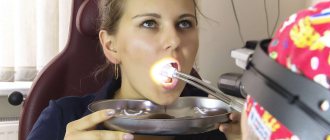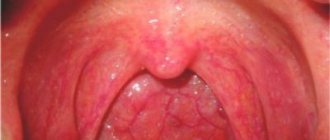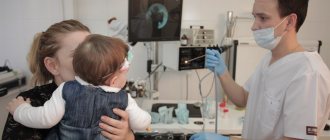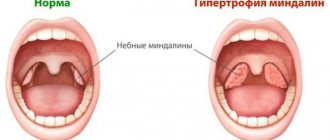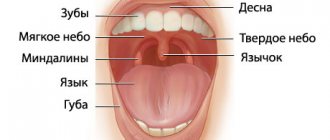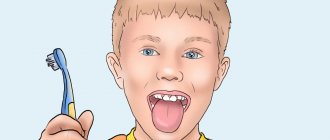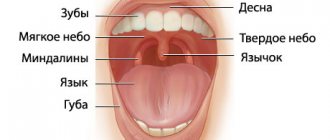The development of inflammatory pathologies of the palatine tonsils is often accompanied by the formation of purulent-caseous plugs in the recesses of accumulations of lymphoid tissue. As the disease progresses, the cheesy deposits thicken, enlarge and begin to cause discomfort. Rinsing the lacunae of the tonsils is the optimal method of conservative treatment that removes plugs
.
Why do you need to rinse your tonsils?
Human tonsils (tonsils) have a special structure. They have deep slits (ducts) called lacunae. This is a place where different types of bacteria accumulate and where drainage is impaired. Food debris, dead epithelial cells and microorganisms that decompose organic matter contribute to the formation of plugs in the lacunae. Many people face a problem during upper respiratory tract diseases. The plugs are white or yellowish lumps. In this case, the tonsils become a source of infection. From them, toxins enter the body and damage internal organs.
When treatment is not started in a timely manner and the resulting lumps are not eliminated, the tonsils become inflamed and tonsillitis develops. If the disease becomes chronic, various complications are possible, in particular glomerulonephritis and rheumatism.
Remove or treat?
Among experienced patients, there are many stories from the series: “Previously, the problem was solved simply - you just need to remove the tonsils, and life will sparkle with bright colors.” Many patients purposefully come to an ENT doctor with a request to get rid of tonsils once and for all. However, many do not understand that by removing such an important organ of the immune system, a person is deprived of a natural barrier against infection. Yes, the problem of tonsillitis will disappear, but other diseases, for example, of the respiratory tract, will take their place. Bacteria and viruses will be able to freely enter the body, causing inflammation of other human organs and systems.
To remove tonsils according to indications, you need:
- often have a sore throat (more than four times a year);
- have a history of peritonsillar abscess;
- have poor rheumatic test scores;
- diagnose complications in your heart, kidneys or joints.
If there are no direct indications for removal, you need to contact an otolaryngologist to prescribe competent complex therapy, which will significantly increase the duration of remission and reduce the number of exacerbations.
One of the most effective procedures for treating tonsillitis, which avoids removal, is washing the palatine tonsils.
Features of the treatment of tonsillitis
Treatment of the disease must be timely and comprehensive. Washing the tonsils is one of the methods of conservative treatment of chronic tonsillitis with purulent discharge. This technique is used along with injections into the parenchyma and capsule of the tonsils, UV rays, x-ray therapy, etc.
Treatment should be carried out not only by an ENT doctor and therapist. Dental services may be needed. The best results in the treatment of ENT organs can be achieved if the teeth are simultaneously treated and careful individual oral hygiene is established. The fact is that carious cavities, soft plaque and tartar are a source of infection. No matter how hard you try to eliminate germs from the tonsils, new pathogens will migrate to them from the oral cavity.
Contraindications to the procedure
Properly performed sanitation of the tonsils is a highly effective procedure for chronic tonsillitis. But in some cases, the patient may be refused to undergo lavage. Contraindications to manipulation are:
- an infectious disease in the acute stage (here we are talking not only about inflammation of the tonsils, but about any inflammatory processes in the oropharynx. Even carious teeth can cause refusal to carry out the procedure, since during manipulation the infection can get to healthy tissues);
- oncological diseases;
- retinal diseases;
- first and last trimesters of pregnancy;
- diseases of the cardiovascular system;
- high blood pressure;
- children under three years old;
- individual intolerance to the solutions used for washing.
In other cases, washing the palatine tonsils, carried out by a competent ENT doctor, gives an excellent result and allows you to achieve long-term remission when the symptoms of the disease do not bother you. The procedure is safe and well tolerated by patients. And most importantly, a high-quality procedure allows you to save the tonsils and avoid surgery to remove them.
There are several methods for carrying out the procedure: sanitation using a syringe and the vacuum method of washing the tonsils.
Clinical picture
The formation of plugs in the tonsils is accompanied by the following symptoms:
- pungent and unpleasant odor from the mouth;
- cough;
- discomfort when swallowing;
- periodic sore throat;
- dryness;
- enlargement of the submandibular lymph nodes;
- weakness and fatigue;
- increase in body temperature.
The patient may suffer from frequent sore throats and other throat diseases.
If the first unpleasant symptoms occur, you should consult a doctor. Only after consulting a specialist can you self-treat your tonsils at home. The procedure is the same as in a clinical setting.
Flushing the tonsils with an irrigator
First you need to choose a suitable irrigator model. It can be portable or stationary, pulsed or microbubble. Portable models are not suitable for washing tonsils, as they have one significant drawback - the inability to smoothly switch the water supply mode. A sudden change in pressure and jet pressure can lead to tissue injury. Therefore, it is better to choose stationary models for washing the tonsils.
They are more functional and have several operating modes, including for cleaning gums and tonsils. In addition, stationary irrigators come with several nozzles, while portable ones are sold with one, or maximum two nozzles.
The minimum value of the cleaning jet pressure created by an irrigator suitable for washing tonsils should not be more than 150 kPa. Waterpik WP-108 E2 Ultra is ideal for this procedure - a stationary device that supplies pressure from 70 to 560 kPa. There is a lever on the handle for smooth switching of modes. You need to start the procedure with the weakest pressure, gradually increasing it. The device comes complete with 7 attachments. One of them is designed to clean gum pockets. It can also be used to wash the tonsils. Two standard attachments are also suitable for this.
Another suitable irrigator that can be used to wash tonsils is available under the brand name Aquapick AQ-300. It has several operating modes and 4 attachments included. The reservoir is quite large - 600 ml. It is enough for a complete cleaning for two or three family members. This device can be mounted on the bathroom wall using a bracket. It is not cheap, but it is one of the most functional. There is also a more budget option - B.Well WI-922. This device can be used to clear tonsils, but the minimum power it produces is 200 kPa. This irrigator is not suitable for children to wash their tonsils.
Our online store offers many stationary irrigators that can be used for washing tonsils. When purchasing, consider the following indicators: jet power, minimum pressure, number of operating modes, pulsation frequency and tank volume. Now we’ll find out how to rinse your tonsils with an irrigator at home.
How to wash tonsils at home
Antiseptic and antibacterial drugs are used to treat the tonsils. With their help, it is possible to eliminate the source of infection, as well as relieve inflammation. The following tools can be used for the procedure:
- saline;
- alcohol-containing solutions;
- furatsilin;
- soda-salt solution with the addition of a few drops of iodine;
- herbal decoctions.
Your doctor will help you determine the appropriate product for irrigating your tonsils.
Clogged tonsils, wax plugs in the throat, what is it?
The tonsils perform a protective function in the human body; they are also the site of all accumulations. What is meant? Every human organ has channels, with their help blood circulates, accumulated decay substances are removed, information is transmitted, and all systems function interconnectedly. The same goes for the tonsils. Their channels are called lacunae. Dead cells, bacteria, and mucus secreted by the nasopharynx accumulate inside each one. For most people, this process goes through without difficulty, functions independently and gets rid of savings in a timely manner. But people and children with reduced immunity have problems.
Caseous plugs appear as a result of various colds. Pus flows onto the surface of the tonsils and forms a film that can be easily removed with a spatula. But advanced cases will bring much more discomfort, forming those same caseous accumulations. Sulfur lumps are gray-yellow formations that are slightly compacted. They are located on top of the tonsils or clogged inside the canals of the lacunae. This nuisance can often be found in people suffering from tonsillitis or tonsillitis. But, no matter how scary the descriptions and names of the diseases may sound, there is no reason to worry too much. Doctors say that a similar symptom can occur in anyone, even the healthiest person.
Speaking of causes and symptoms!
How to clean tonsils
You can minimize the side effects of tonsillitis by regularly doing preventive rinsing of your tonsils at home. To do this, you need to take a syringe (10 ml) without a needle or a small syringe with a soft, long tip. The procedure is carried out in front of a mirror. You need to keep your head straight to control the direction of the jet in the reflection of the mirror. When irrigating, they hold their breath. Tonsils need to be treated closer to the lacunae. Washing is carried out in stages:
- The mouth is rinsed with boiled water or herbal decoction.
- Draw an antiseptic into a syringe (syringe).
- The lacunae are treated with liquid pressure.
- The mouth is rinsed with an antiseptic.
The tonsils are washed from pus up to 5 times a day, always after each meal. The procedure can be carried out using an irrigator using a standard nozzle. To do this, a minimum pressure level is set on it. The tonsils are washed one by one.
Since the liquid washes out pathogenic bacteria from the ducts, it must be constantly spat out. Otherwise, the infection gets inside, which can cause inflammation in the larynx, lungs, and bronchi. For such actions to be effective, it is important to maintain a water regime, as well as take additional medications prescribed by the doctor.
Vacuum method
To carry out the manipulation, an ultrasonic device “Tonsillor” is used. As standard, the device comes with a vacuum nozzle for washing gland lacunae. At the beginning of the manipulation, the ENT doctor performs topical anesthesia of the palatine tonsils with a solution of Lidocaine. The patient sits comfortably in a chair and opens his mouth.
The vacuum nozzle is brought to the surface of the tonsils and attached to it. The washing solution is fed through a nozzle, passes through the gaps and, under pressure, washes out all the pathogenic contents from them. Antiseptic or saline solutions are used as flushing solutions. The solution passes through the thickness of the tonsil once and is not reused, since after washing it is removed into a special suction.
Since the waste solution goes directly into the suction, infection of healthy tissues during the manipulation is excluded.
The procedure is carried out under the influence of ultrasonic vibrations, which allows the medicine to penetrate deeper layers of tissue, and this contributes to a rapid recovery.
In general, the procedure on the Tonsillor apparatus resembles the principle of operation of a vacuum cleaner. This vacuum sanitation allows you to effectively clean the lacunae of the tonsils and get rid of purulent accumulations.
On average, five to ten sessions are required to achieve a lasting therapeutic effect.
At this point we could put a full stop and end the article. But there is another way to carry out vacuum rinsing - using a modified attachment of the Tonsillor device, which is used only in the ENT Clinic of Doctor Zaitsev.
Positive effects of tonsil rinsing
As a result of washing out purulent plugs, your well-being significantly improves, namely:
- pain syndrome is alleviated;
- cough is eliminated;
- bad breath disappears, as harmful microorganisms and fungus are eliminated;
- immunity of mucous membranes increases;
- the microflora on the surface of the tonsils is restored.
After washing the tonsils to remove plugs, the risk of pathogen proliferation and the development of throat diseases is significantly reduced.
Possible complications when washing the tonsils
The procedure requires some experience. If you don't get it right the first time, don't be discouraged. Each time you do it, you will do better and you will need to visit the doctor less and less often. But remember that incorrect actions can aggravate the problem and injure the mucous membrane of the mouth and pharynx. Thus, some plugs under the pressure of the injected product may not be washed out, but fall into even deeper layers. In addition, the syringe injures the lymphoid tissue, which over time leads to scarring of the mucosa and deterioration of its natural patency.
It is worth considering that outpatient treatment is much more effective than home treatments.
